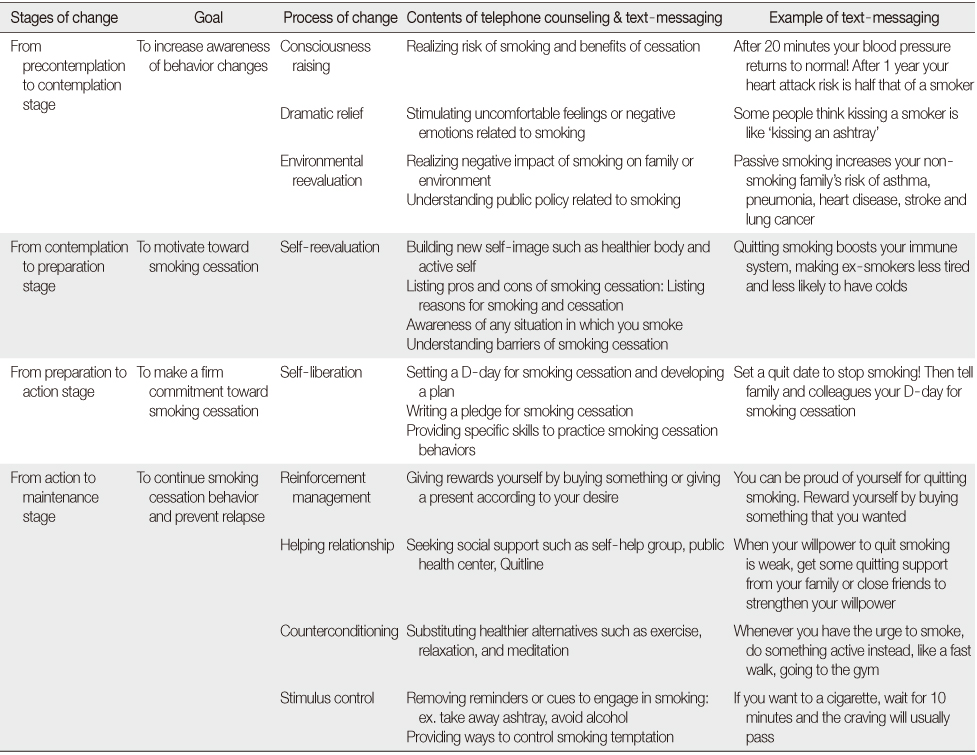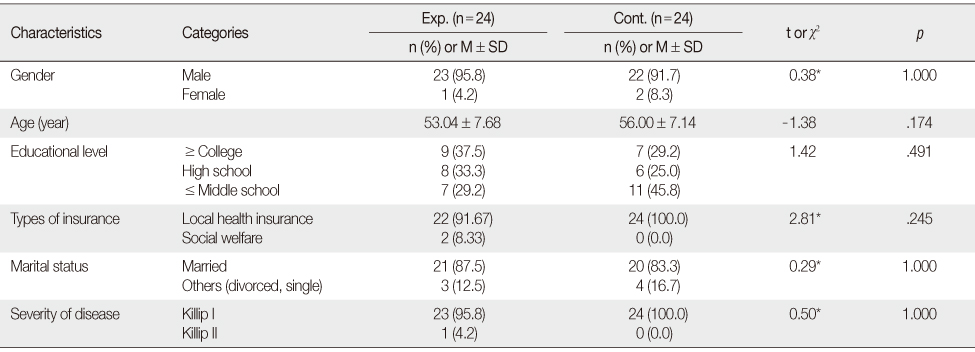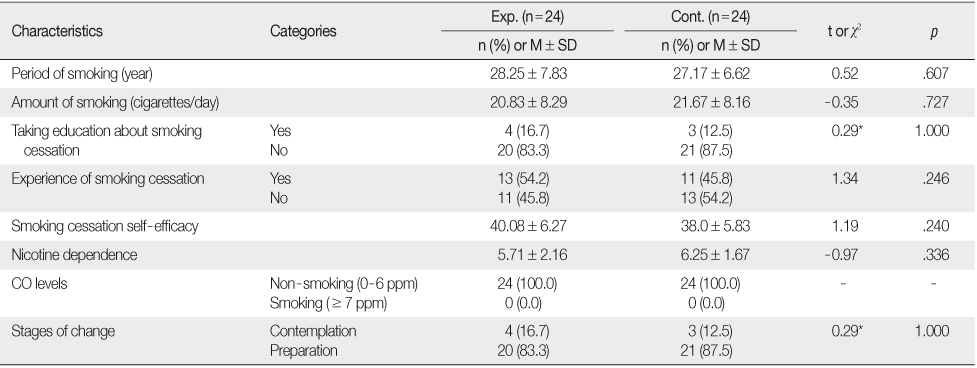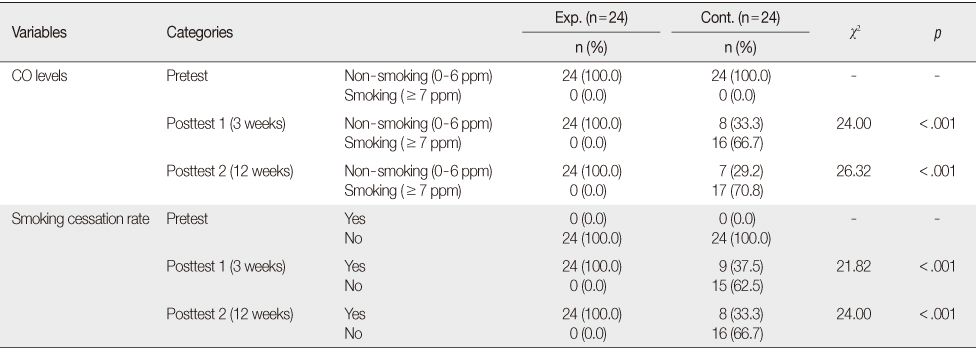Articles
- Page Path
- HOME > J Korean Acad Nurs > Volume 43(4); 2013 > Article
-
Original Article
- Effects of a Smoking Cessation Program including Telephone Counseling and Text Messaging using Stages of Change for Outpatients after a Myocardial Infarction
- Jung-Hyeon Kong, Yeongmi Ha
-
Journal of Korean Academy of Nursing 2013;43(4):557-567.
DOI: https://doi.org/10.4040/jkan.2013.43.4.557
Published online: August 30, 2013
1Department of Nursing, Cheongam College, Suncheon, Korea.
2College of Nursing · Institute of Health Sciences, Gyeongsang National University, Jinju, Korea.
- Address reprint requests to: Ha, Yeongmi. College of Nursing & Institute of Health Sciences, Gyeongsang National University, 816-15 beon-gil Jinju-daero, Jinju 660-987, Korea. Tel: +82-55-772-8253, Fax: +82-55-772-8222, yha@gnu.ac.kr
© 2013 Korean Society of Nursing Science
Abstract
-
Purpose
- This study was done to identify effects of a smoking cessation program including telephone counseling and text messaging using stages of change for outpatients who have had a myocardial infarction (MI).
-
Methods
- This research was a quasi-experimental design with a nonequivalent control group pretest-posttest. The participants were 48 outpatients (experimental group=24, control group=24) recruited from one university hospital. They were randomly assigned to one of two groups: (a) an experimental group with telephone counseling (once a week) and text messaging (five times a week) using stages of change, and (b) a control group with traditional telephone counseling (once a month). Efficacy of the intervention was measured by comparing the two groups on smoking-related variables at 3 weeks and 12 weeks.
-
Results
- At the 3-week and 12-week measurements, there were significant differences between the experimental and control groups on smoking cessation self-efficacy (p<.001), nicotine dependence (p<.001), CO levels (p<.001), and smoking cessation rates (p<.001).
-
Conclusion
- The results indicate that the smoking cessation program including telephone counseling and text messaging using stages of change is effective for outpatients after a MI. Further attention should be paid to the intensity of the smoking cessation program and periods for long-term follow-up.
- 1. Ahn HK, Lee HJ, Jung DS, Lee SY, Kim SW, Kang JH. The reliability and validity of Korean version of questionnaire for nicotine dependence. J Korean Acad Fam Med. 2002;23(8):999–1008.
- 2. Aveyard P, Lawrence T, Cheng KK, Griffin C, Croghan E, Johnson C. A randomized controlled trial of smoking cessation for pregnant women to test the effect of a transtheoretical model-based intervention on movement in stage and interaction with baseline stage. Br J Health Psychol. 2006;11(Pt 2):263–278. http://dx.doi.org/10.1348/135910705x52534ArticlePubMed
- 3. Balmford J, Borland R, Benda P, Howard S. Factors associated with use of automated smoking cessation interventions: Findings from the eQuit study. Health Educ Res. 2013;28(2):288–299. http://dx.doi.org/10.1093/her/cys104ArticlePubMed
- 4. Barth J, Critchley J, Bengel J. Psychosocial interventions for smoking cessation in patients with coronary heart disease. Cochrane Database Syst Rev. 2008;(1):CD006886. http://dx.doi.org/10.1002/14651858.cd006886Article
- 5. Cahill K, Lancaster T, Green N. Stage-based interventions for smoking cessation. Cochrane Database Syst Rev. 2010;(11):CD004492. http://dx.doi.org/10.1002/14651858.CD004492.pub4Article
- 6. Chang SO, Kim EJ, Kil SY, Seomun GA, Lee SJ. Influential variables on intention and action to quit smoking between adolescent smokers and adult smokers-based on the transtheoretical model. J Korean Acad Nurs. 2005;35(7):1410–1419.ArticlePDF
- 7. Cho KS, Song TM. Analysis of key factors in smoking cessation and cost effectiveness at public health centers. Health Welf Policy Forum. 2006;12:65–77.
- 8. Critchley JA, Capewell S. Mortality risk reduction associated with smoking cessation in patients with coronary heart disease: A systematic review. JAMA. 2003;290(1):86–97. http://dx.doi.org/10.1001/jama.290.1.86ArticlePubMed
- 9. Dornelas EA, Sampson RA, Gray JF, Waters D, Thompson PD. A randomized controlled trial of smoking cessation counseling after myocardial infarction. Prev Med. 2000;30(4):261–268. http://dx.doi.org/10.1006/pmed.2000.0644ArticlePubMed
- 10. Faul F, Erdfelder E, Lang AG, Buchner A. Statistical power analyses using G*Power 3.1: Tests for correlation and regression analyses. Behav Res Methods. 2009;41(4):1149–1160. http://dx.doi.org/10.3758/BRM.41.4.1149ArticlePubMedPDF
- 11. Brunner Frandsen N, Sorensen M, Hyldahl TK, Henriksen RM, Bak S. Smoking cessation intervention after ischemic stroke or transient ischemic attack. A randomized controlled pilot trial. Nicotine Tob Res. 2012;14(4):443–447. http://dx.doi.org/10.1093/ntr/ntr233ArticlePubMed
- 12. Haug S, Meyer C, Schorr G, Bauer S, John U. Continuous individual support of smoking cessation using text messaging: A pilot experimental study. Nicotine Tob Res. 2009;11(8):915–923. http://dx.doi.org/10.1093/ntr/ntp084ArticlePubMed
- 13. Health Insurance Review & Assessment Service. 2011 National health insurance statistical yearbook. 2012.Retrieved December 15, 2012. from http://www.hira.or.kr/cms/information/05/03/01/__icsFiles/afieldfile/2012/12/10/2011.pdf
- 14. Heatherton TF, Kozlowski LT, Frecker RC, Fagerstrom KO. The fagerstrom test for nicotine dependence: A revision of the fagerstrom tolerance questionnaire. Br J Addict. 1991;86(9):1119–1127.PubMed
- 15. Hyun HJ, Ahn HY. An analysis of the research on effect of smoking cessation intervention. J Korean Acad Community Health Nurs. 2008;19(3):469–479.
- 16. Kim H, Kwon EJ, Lim J, Jung H, Cha JK, Cho S, et al. The effects of smoking cessation clinics in the Korean armed forces: Application of the transtheoretical model and life skill approaches. Korean J Health Educ Promot. 2011;28(4):79–94.
- 17. Kim YH, Kim JS, Kim MS. Effectiveness of public health center smoking cessation counseling program using the transtheoretical model. J Korean Acad Nurs. 2009;39(4):469–479. http://dx.doi.org/10.4040/jkan.2009.39.4.469ArticlePubMed
- 18. Korea Internet and Security Agency. 2012 Survey on the internet usage. 2013.Retrieved March 23, 2013. from http://isis.kisa.or.kr/board/index.jsp?pageId=040100&bbsId=7&itemId=792&pageIndex=1
- 19. Naughton F, Prevost AT, Gilbert H, Sutton S. Randomized controlled trial evaluation of a tailored leaflet and SMS text message self-help intervention for pregnant smokers (MiQuit). Nicotine Tob Res. 2012;14(5):569–577. http://dx.doi.org/10.1093/ntr/ntr254ArticlePubMed
- 20. Park SS, Lee JY, Cho SI. Validity of expired carbon monoxide and urine cotinine using dipstick method to assess smoking status. J Prev Med Public Health. 2007;40(4):297–304. http://dx.doi.org/10.3961/jpmph.2007.40.4.297ArticlePubMed
- 21. Prochaska JO, DiClemente CC. The transtheoretical approach: Crossing traditional boundaries of therapy. Malabar, FL: Krieger Pub Co; 1994.
- 22. Prochaska JO, DiClemente CC, Norcross JC. In search of how people change. Applications to addictive behaviors. Am Psychol. 1992;47(9):1102–1114.ArticlePubMed
- 23. Prochaska JO, Velicer WF, DiClemente CC, Fava J. Measuring processes of change: Applications to the cessation of smoking. J Consult Clin Psychol. 1988;56(4):520–528.ArticlePubMed
- 24. Rigotti NA, Clair C, Munafo MR, Stead LF. Interventions for smoking cessation in hospitalised patients. Cochrane Database Syst Rev. 2012;5:CD001837. http://dx.doi.org/10.1002/14651858.CD001837.pub3ArticlePubMed
- 25. Ryu SY, Shin JH, Kang MG, Park J. Factors associated with intention to quit smoking among male smokers in 13 communities in honam region of Korea: 2010 community health survey. Korean J Health Educ Promot. 2011;28(2):75–85.
- 26. Sim DS, Kim JH, Jeong MH. Differences in clinical outcomes between patients with ST-elevation versus non-ST-elevation acute myocardial infarction in Korea. Korean Circ J. 2009;39(8):297–303. http://dx.doi.org/10.4070/kcj.2009.39.8.297ArticlePubMedPMC
- 27. Statistics Korea. The cause of death statistics: 2011. 2012;Retrieved December 15, 2012. from http://kostat.go.kr/portal/korea/kor_nw/2/1/index.board?bmode=read&bSeq=&aSeq=260046&page
- 28. Stead LF, Perera R, Lancaster T. Telephone counselling for smoking cessation. Cochrane Database Syst Rev. 2006;(3):CD002850. http://dx.doi.org/10.1002/14651858.CD002850.pub2
- 29. Velicer WF, DiClemente CC, Rossi JS, Prochaska JO. Relapse situations and self-efficacy: An integrative model. Addict Behav. 1990;15(3):271–283.ArticlePubMed
- 30. Whittaker R, Borland R, Bullen C, Lin RB, McRobbie H, Rodgers A. Mobile phone-based interventions for smoking cessation. Cochrane Database Syst Rev. 2009;(4):CD006611. http://dx.doi.org/10.1002/14651858.CD006611.pub2Article
- 31. Whittaker R, McRobbie H, Bullen C, Borland R, Rodgers A, Gu Y. Mobile phone-based interventions for smoking cessation. Cochrane Database Syst Rev. 2012;11:CD006611. http://dx.doi.org/10.1002/14651858.CD006611.pub3PubMed
REFERENCES

Figure & Data
REFERENCES
Citations

- The effects of emotional distress on attentional bias toward cigarette warnings according to smokers' anxiety levels
Younji Jung, Jang-Sun Hwang, Jang-Han Lee
Frontiers in Psychology.2024;[Epub] CrossRef - Factors Related to Smoking Relapse Within Six-Months of Smoking Cessation Among Inpatients
Ji Eun Bae, Chul-Woung Kim, Seung Eun Lee, Myungwha Jang
Research in Community and Public Health Nursing.2023; 34: 307. CrossRef - The effectiveness of a motivational text-messaging program for smoking cessation after coronary angioplasty: a quasi-experimental study
Mohammad Sadegh Mobaraki, Zahra Khademian, Fatemeh Shirazi
BMC Research Notes.2023;[Epub] CrossRef - Improving smoking cessation after myocardial infarction by systematically implementing evidence-based treatment methods
Margret Leosdottir, Sanne Wärjerstam, Halldora Ögmundsdottir Michelsen, Mona Schlyter, Emma Hag, John Wallert, Matz Larsson
Scientific Reports.2022;[Epub] CrossRef - Improving the quality of bowel preparation by smartphone education platform prior to colonoscopy: a randomized trail
Kai Zhao, Ruonan Dong, Suhong Xia, Lina Feng, Wangdong Zhou, Mingyu Zhang, Yu Zhang, Dean Tian, Mei Liu, Jiazhi Liao
Annals of Medicine.2022; 54(1): 2776. CrossRef - Personalized Reminders for Immunization Using Short Messaging Systems to Improve Human Papillomavirus Vaccination Series Completion: Parallel-Group Randomized Trial
Chelsea S Wynn, Marina Catallozzi, Chelsea A Kolff, Stephen Holleran, Dodi Meyer, Rajasekhar Ramakrishnan, Melissa S Stockwell
JMIR mHealth and uHealth.2021; 9(12): e26356. CrossRef - The effect of theory - Based educational intervention on consumption of smokeless tobacco products by merchants’ guilds
Mohammad Saeed Jadgal, Somayeh Alizadeh, Hadi Alizadeh -Siuki, Saeedeh Sadeghi, Tahmineh Salehian, Moradali Zareipour
Journal of Education and Health Promotion.2021; 10(1): 428. CrossRef - Effect of WeChat and short message service on bowel preparation: an endoscopist-blinded, randomized controlled trial
Shu-Ling Wang, Qian Wang, Jun Yao, Sheng-Bing Zhao, Li-Sheng Wang, Zhao-Shen Li, Yu Bai
European Journal of Gastroenterology & Hepatology.2019; 31(2): 170. CrossRef - The Effects of Auricular Acupressure on Smoking Cessation for Male College Students
Shinae Lee, Hyojung Park
Western Journal of Nursing Research.2017; 39(3): 374. CrossRef - Enhanced education for bowel preparation before colonoscopy: A state‐of‐the‐art review
Zhu Liu, Ming Ming Zhang, Yue Yue Li, Li Xiang Li, Yan Qing Li
Journal of Digestive Diseases.2017; 18(2): 84. CrossRef - Factors Affecting Smoking Cessation Success during 4-week Smoking Cessation Program for University Students
Sang Mee Koo, Jeong Hee Kang
Journal of Korean Academy of Community Health Nursing.2017; 28(2): 165. CrossRef - The Effects of Smoking Cessation Coaching Program based on Motivation Stage to Stop Smoking of Patients at a Public Hospital
Mi-Young Kwak, Eun Jeong Hwang
Journal of the Korea Academia-Industrial cooperation Society.2016; 17(4): 188. CrossRef - Continuous Abstinence Rates from Smoking Over 12 Months according to the Frequency of Participation in a Hospital-based Smoking Cessation Program among Patients Discharged after Acute Myocardial Infarction
Young-Hoon Lee, Mi-Hee Han, Mi Rim Lee, Jin-Won Jeong, Nam-Ho Kim, Seok Kyu Oh, Kyeong Ho Yun, Sang Jae Rhee, Jum Suk Ko, Gyung-Jae Oh
Korean Journal of Health Promotion.2016; 16(1): 48. CrossRef - The effectiveness of mobile-health behaviour change interventions for cardiovascular disease self-management: A systematic review
Leila Pfaeffli Dale, Rosie Dobson, Robyn Whittaker, Ralph Maddison
European Journal of Preventive Cardiology.2016; 23(8): 801. CrossRef - Effect of Auricular Acupressure Therapy on Decreasing Smoking rates, Desire for Smoking, and Exhaled Carbon Monoxide in Male College Students
Oh Yun Kwon, Jung Hee Song, Kyung Sook Park
The Korean Journal of Rehabilitation Nursing.2015; 18(2): 88. CrossRef - The Effects of Job Characteristics on Smoking and Mediating Effects of Job Stress among Older Workers
Sungeun Lee
Korean Journal of Health Education and Promotion.2014; 31(3): 51. CrossRef - Effects of a Smoking Cession Program Using Telephone Counselling and Text Messaging for Patients after Ischemic Heart Disease
Eun-Shim Kim, Hye-Ok Choi
Journal of the Korea Academia-Industrial cooperation Society.2014; 15(12): 7248. CrossRef
Intervention Principle of Stage-matched Smoking Cessation Program using Telephone Counseling and Text Messaging
Homogeneity Test of General Characteristics of the Participants
Exp.=Experimental group; Cont.=Control group.
*χ2 with Fishers' exact test.
Homogeneity Test of the Smoking-related Characteristics of the Participants
Exp.=Experimental group; Cont.=Control group; CO=Carbon monoxide.
*χ2 with Fishers' exact test.
Mean Scores of Smoking Cessation Self-efficacy and Nicotine Dependence between the Two Groups at 3 Weeks and 12 Weeks
Exp.=Experimental group; Cont.=Control group.
CO Levels and Smoking Cessation Rate between the Two Groups at 3 Weeks and 12 Weeks
CO=Carbon monoxide; Exp.=Experimental group; Cont.=Control group.
Exp.=Experimental group; Cont.=Control group. *χ2 with Fishers' exact test.
Exp.=Experimental group; Cont.=Control group; CO=Carbon monoxide. *χ2 with Fishers' exact test.
Exp.=Experimental group; Cont.=Control group.
CO=Carbon monoxide; Exp.=Experimental group; Cont.=Control group.
 KSNS
KSNS
 E-SUBMISSION
E-SUBMISSION




 Cite
Cite

